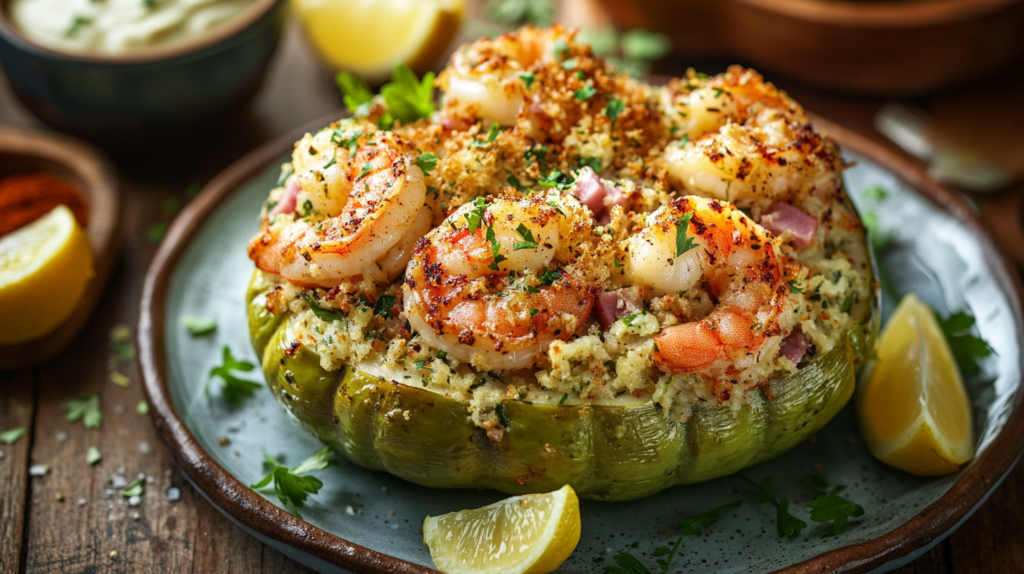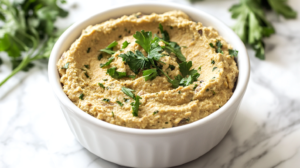Introduction
Mirliton, also known as chayote squash, is a unique vegetable that has earned a special place in cuisines around the world. Whether served as a savory side dish, stuffed with flavorful ingredients, or incorporated into hearty stews, this pear-shaped squash is both versatile and delicious. In Louisiana, mirliton holds a cultural significance as a traditional ingredient in Creole and Cajun cooking, often making an appearance at family gatherings and holiday feasts.
The subtle flavor and tender texture of mirliton allow it to adapt beautifully to a variety of recipes. Its journey from ancient Mesoamerican diets to contemporary kitchens showcases its resilience and culinary adaptability. For an exciting take on stuffed dishes, consider exploring Roasted Stuffed Bell Peppers, which also feature bold flavors and satisfying textures.
History and Origins
The Ancient Roots of Mirliton
Mirliton has a rich history that dates back to the fertile regions of Mesoamerica, specifically modern-day Mexico and Guatemala. Known scientifically as Sechium edule, it is part of the gourd family and was a staple in the diets of indigenous peoples. Its cultivation dates back thousands of years, where it thrived in warm, tropical climates and was valued for its adaptability and nutritional benefits.
During the Columbian Exchange, mirliton spread across the globe, finding new homes in the Caribbean, Louisiana, Southeast Asia, and beyond. In Louisiana, French and Spanish settlers adopted the vegetable, integrating it into Creole and Cajun cuisines. Today, mirliton is a beloved ingredient, especially during the holiday season when it’s featured in dishes like stuffed mirliton and casseroles.

Botanical Characteristics
What Does Mirliton Look Like?
Mirlitoni is instantly recognizable by its:
- Shape: Pear-like with a wrinkled, green exterior.
- Texture: Firm yet tender flesh that softens when cooked.
- Seed: A large, flat seed located in the center.
These features make mirlitoni not only easy to prepare but also versatile in culinary applications. Its mild flavor pairs well with bold ingredients like seafood, spices, and fresh herbs.
Growing and Varieties
Mirlitoni grows on climbing vines that flourish in warm, humid environments. In Louisiana, home gardeners often grow mirlitoni on backyard trellises, where the vines yield abundant fruit. There are two primary varieties:
- Smooth-Skinned Mirliton: More common in culinary use.
- Spiny-Skinned Mirliton: Known for its tougher exterior but equally delicious flesh.
For those interested in experimenting with fresh produce, consider pairing mirlitoni with recipes like Mediterranean Quinoa Power Bowl, which incorporates vibrant, nutritious vegetables.
Nutritional Benefits
Why Choose Mirliton?
Mirlitoni is a low-calorie vegetable packed with essential nutrients, making it a healthy choice for any meal.
- Dietary Fiber: Promotes healthy digestion and keeps you feeling full.
- Vitamin C: Strengthens the immune system and protects against free radicals.
- Potassium: Regulates blood pressure and supports muscle function.
- Hydration: With its high water content, mirliton contributes to daily hydration needs.
This squash is also rich in antioxidants, which help reduce inflammation and support overall health. For more information on its health benefits, explore Nutritional Benefits of Chayote.
How to Select and Prepare Mirliton
Tips for Choosing Fresh Mirliton
When shopping for mirlitoni, look for the following:
- Firm Texture: Avoid soft spots or blemishes.
- Bright Green Color: Indicates freshness and quality.
- Medium Size: Larger mirlitons may have tougher skin and less flavor.
Store mirlitoni in a cool, dry place or refrigerate to maintain freshness for up to two weeks.
Preparing Mirliton
- Wash Thoroughly: Rinse the vegetable under running water to remove dirt.
- Peel (Optional): Smooth-skinned varieties don’t require peeling, but spiny ones should be peeled with a vegetable peeler.
- Remove the Seed: Slice the mirlitoni in half and scoop out the central seed.
- Cut as Needed: Dice, slice, or hollow out the flesh, depending on the recipe.
For dishes that celebrate fresh ingredients, try combining mirlitoni with Garlic Parmesan Sauce, a creamy companion to its mild flavor.
Cooking Methods
Mirliton is incredibly versatile and can be:
- Boiled: Softens the flesh for salads or casseroles.
- Baked: Enhances flavor and adds a slight caramelized sweetness.
- Sautéed: Retains some firmness and pairs well with garlic and onions.
Traditional Uses in Louisiana Cuisine
In Louisiana, mirliton is an essential ingredient in Creole and Cajun dishes. Its ability to absorb flavors makes it ideal for recipes like:
- Stuffed Mirlitoni: Filled with shrimp, ham, and breadcrumbs for a savory main course.
- Mirlitoni Casserole: A creamy, comforting dish often served during holidays.
- Boiled Mirlitoni Salad: A refreshing side dish perfect for warm weather.
These recipes highlight the versatility of mirlitoni and its importance in regional cooking traditions.
Wrapping Up Part 1
In Part 1, we explored the rich history, characteristics, and nutritional benefits of mirliton. This unique vegetable has traveled across continents, earning a place in both traditional and modern cuisines. Whether you’re cooking a classic Creole dish or experimenting with global flavors, mirlitoni offers endless possibilities.
In Part 2, we’ll dive deeper into creative recipes, global variations, and frequently asked questions to help you master this versatile squash. Stay tuned!
Traditional Recipes
Mirliton has earned its reputation as a versatile ingredient in a variety of dishes, from comforting casseroles to elegant stuffed presentations. Below are some timeless recipes that showcase its adaptability.
Stuffed Mirliton with Shrimp and Ham
This classic dish is a Louisiana favorite, often served at holiday gatherings.
Ingredients:
- 4 large mirlitons
- 1 cup cooked shrimp, chopped
- 1 cup diced ham
- 1 cup breadcrumbs
- 1 small onion, finely diced
- 1/2 cup celery, finely chopped
- 2 tbsp butter
- Salt, pepper, and Creole seasoning to taste
Instructions:
- Prepare the Mirlitons: Boil the mirlitons until tender, slice them in half, and scoop out the flesh. Reserve the shells for stuffing.
- Make the Filling: Sauté onions, celery, and butter. Add the diced shrimp, ham, and scooped mirliton flesh. Mix in breadcrumbs and seasoning.
- Stuff and Bake: Spoon the mixture into the shells and bake at 375°F for 20–25 minutes until golden.
For a similar stuffed dish with a twist, try Roasted Stuffed Bell Peppers, which pairs bold fillings with vibrant peppers.

Mirliton Casserole
This creamy, breadcrumb-topped casserole is a comforting side dish that’s perfect for special occasions.
Ingredients:
- 4 mirlitons, peeled and sliced
- 1 cup heavy cream
- 1/2 cup grated Parmesan cheese
- 1 cup breadcrumbs
- 1/2 cup melted butter
- Salt, pepper, and nutmeg to taste
Instructions:
- Boil and Slice: Cook the mirlitons until tender, then slice thinly.
- Assemble the Casserole: Layer the mirliton slices in a baking dish, drizzle with cream, and season. Top with breadcrumbs, Parmesan, and melted butter.
- Bake: Cook in a 375°F oven for 25–30 minutes until bubbly and golden brown.
Boiled Mirliton Salad
This light and refreshing salad is an excellent accompaniment to grilled seafood or chicken.
Ingredients:
- 3 mirlitons, boiled and sliced
- 1 cup cherry tomatoes, halved
- 1/2 cup red onion, thinly sliced
- 1/4 cup olive oil
- 2 tbsp red wine vinegar
- Fresh parsley, chopped
Instructions:
- Combine the boiled mirliton slices with tomatoes, onions, and parsley.
- Drizzle with olive oil and red wine vinegar, then toss gently.
- Season with salt and pepper before serving.
Modern and Global Variations
While mirlitoni is a staple in Louisiana cooking, its adaptability makes it an exciting ingredient in global dishes.
Caribbean-Inspired Mirliton Curry
Ingredients:
- 2 mirlitons, diced
- 1 can coconut milk
- 1 cup chickpeas, cooked
- 1 tbsp curry powder
- 1/2 tsp turmeric
- Fresh cilantro for garnish
Instructions:
- Sauté diced mirlitoni in oil until slightly tender.
- Add curry powder, turmeric, and coconut milk, then simmer until the mirlitoni is fully cooked.
- Stir in chickpeas and serve over steamed rice.
Vegetarian Stuffed Mirliton
Replace traditional fillings with a plant-based option.
Ingredients:
- 4 mirlitons
- 1 cup cooked quinoa
- 1 cup mushrooms, diced
- 1/2 cup spinach, chopped
- 1 small onion, diced
Instructions:
- Prepare mirlitons as outlined in the stuffed mirliton recipe.
- Sauté mushrooms, spinach, and onions until tender. Add quinoa and season with salt and pepper.
- Stuff the mixture into the mirlitoni shells and bake at 375°F for 20 minutes.
For another vegetarian-friendly recipe, try Mediterranean Quinoa Power Bowl, which pairs hearty quinoa with fresh vegetables.
Sweet Mirliton Pie
Turn mirliton into a dessert with this pie recipe that rivals traditional apple pie.
Ingredients:
- 2 cups cooked, mashed mirliton
- 1 cup sugar
- 2 eggs, beaten
- 1 tsp vanilla extract
- 1/4 tsp cinnamon
- 1 pre-made pie crust
Instructions:
- Mix the mashed mirliton with sugar, eggs, vanilla, and cinnamon.
- Pour the mixture into the pie crust and bake at 350°F for 40–45 minutes.
- Serve with whipped cream or a scoop of vanilla ice cream.
Frequently Asked Questions
What’s the difference between mirliton and chayote?
Mirliton and chayote are the same vegetable, but the name varies by region. In Louisiana, it’s called mirliton, while chayote is the name commonly used in Latin America and other parts of the world.
Can I eat mirliton raw?
Yes, mirliton can be eaten raw in salads or salsas. Its crisp texture and mild flavor make it a refreshing addition to cold dishes.
How do I store mirliton?
Store uncut mirlitons in the refrigerator for up to two weeks. Once cut, wrap them tightly in plastic or store in an airtight container to maintain freshness.
Are the seeds and leaves edible?
Yes, the seeds of mirliton have a nutty flavor when cooked, and the leaves can be used in soups or stir-fries.
Expanding Your Culinary Repertoire
Mirliton is not just a vegetable—it’s an invitation to experiment with bold flavors and creative recipes. Whether you’re embracing traditional dishes or exploring new culinary horizons, this squash offers endless possibilities.
Similar Dishes to Try
- Creamy Mushroom and Spinach Stuffed Chicken: For another recipe that combines stuffing with rich flavors.
- Garlic Parmesan Sauce: A Creamy and Flavorful Favorite: Pair this sauce with boiled mirliton for a quick and delicious side.
Conclusion
Mirliton is a vegetable with deep cultural roots and a bright future in the kitchen. From classic recipes like Stuffed Mirliton and Mirliton Casserole to innovative global dishes, this squash proves its versatility time and time again.
Ready to dive into the world of mirliton? Start with a traditional recipe or create your own twist by exploring sweet and savory variations. And for even more inspiration, check out Mirliton Recipes, where tradition meets creativity.



